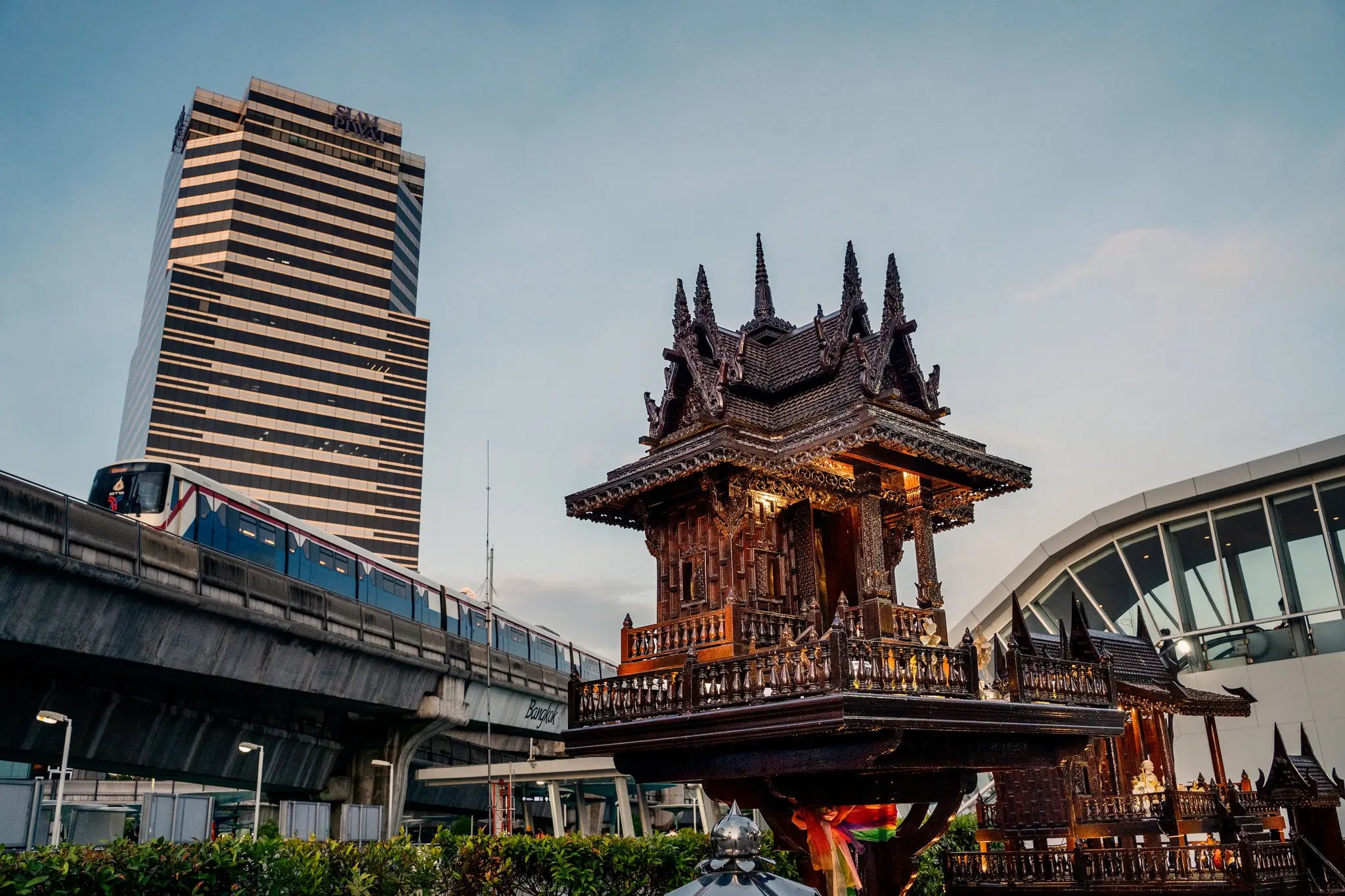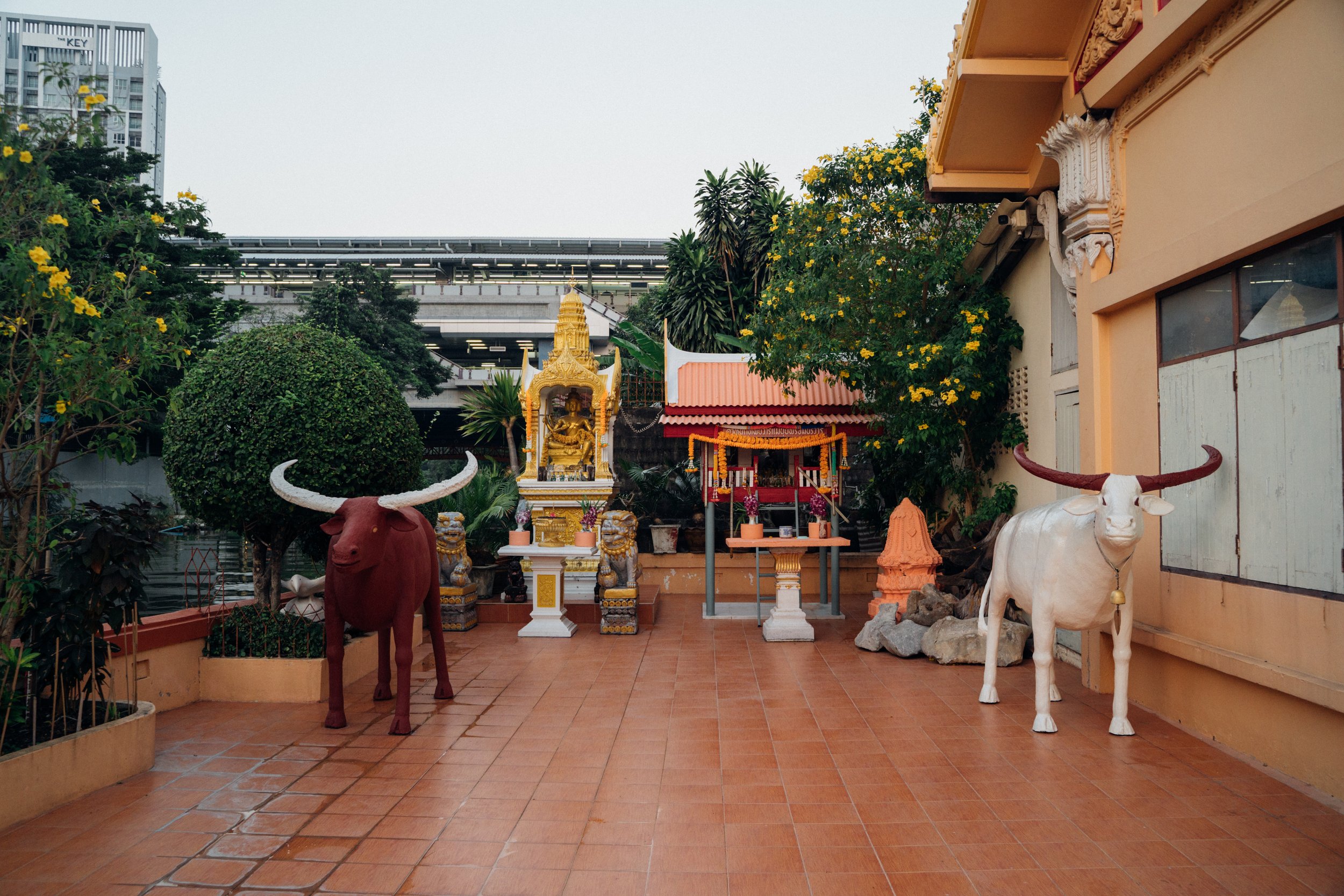Spirits, Shrines, and Red Fanta: A Mystical Walk Through Bangkok
Have you ever seen a spirit house while strolling through the streets of Bangkok? Tiny, ornate structures perched on pedestals, adorned with garlands, incense, offerings, and surprisingly, bottles of Red Fanta. These shrines can be found everywhere throughout Thailand, outside of 7-Eleven, nestled beside homes, tucked behind markets. These are spirit houses, a unique and fascinating part of Thailand’s cultural landscape. But what does these spirit houses truly mean? And what’s the story behind The Red Fanta?
What are Spirit Houses?
Spirit houses are not just for decoration nor are they dollhouses for children. They are deeply spiritual and respected by Thais. While Thailand is predominantly Buddhist, these shrines were not originally part of Buddhist belief systems. Such spirit houses have long existed before the spread of Buddhism in Thailand, coming from animist traditions which the core belief is that every place has a spirit of the land or guardian spirit that must be respected. Thus, the practice of spirit houses actually is a mixture of animism, Buddhism, and even Hindu elements. Ultimately, spirit houses are there for protection purposes. To prevent bad luck or disharmony, a spirit house is built to give that spirit a home.
Other neighbouring countries, like Cambodia and Myanmar, also have similar spirit houses. But Thailand’s tradition stands out due to its synthesis of belief systems and its widespread, visible integration into modern city life. Shrines sit outside of luxury malls, luxury condos, and also 7-Elevens.
(Image credit to Adam Dean, The New York Times)
Not all the spirit houses that you see are the same as well. While they might look similar at first glance, there are key differences in their purpose, design, and the spirits they honor. By looking closer at specific types of spirit houses, we gain a better understanding of how Thai people communicate with and show respect to the spiritual world. Two of the most commonly seen types are the San Phra Phum and the San Jao Ti, each with its own unique symbolism and function.
1. San Phra Phum “ศาลพระภูมิ”
The most commonly seen spirit house. San Phra Phum means the “shrine of the guardian spirit of the land”. A San Phra Phum stands on a single pedestal. Oftentimes you will spot a figure of a deity-like guardian angel inside a San Phra Phum, usually holding a sword or trident. This figure is actually Phra Phum himself, a high-ranking tutelary deity who protects the land and household, keeping bad energy at bay and blessings flowing. Phra Phum, short for Phra Phum Chai Mongkhol “พระภูมิชัยมงคล”, comes from a legend blending Brahmanic and Buddhist beliefs. He was one of nine divine sons of King Thao Thotsaraj “ท้าวทศราช”, tasked with protecting homes. When the king became unjust while ruling over the people of the City of Pali, the god Narayana “Nārāyaṇa”, an avatar of Vishnu reclaimed the land and banished the royal family. After they repented, Narayana allowed them to return as guardian spirits on shrines with a single pillar in the earth. That’s how San Phra Phum shrines began. Today, they’re placed outside homes and buildings across Thailand, where people make offerings for protection, prosperity, and peace.
2. San Jao Ti “ศาลเจ้าที่”
Also known affectionately by Thai locals as the San Ta-Yai “ศาลตายาย” shrine, which translates to the “Grandpa-Grandma” shrine. San Jao Ti means the “shrine of the ancestors who once lived on or protected the land”. These shrines reflect deep-rooted animist beliefs in Thai culture. Before the arrival of Buddhism and Hinduism, animism was the dominant spiritual belief of the Thai people, which centered on the idea that every element of nature possesses a soul or spirit. In this case, the belief is that there are spirits residing on the land. Thus, this shrine houses and honours the spirits of the land. A San Jao Ti differs from the commonly seen San Phra Phum as it stands on four legs, with a ladder in front. This ladder symbolically is for spirits to enter and exit freely, highlighting their domestic nature. It looks just like a tiny house on stilts! Along with the grandparents figurines, you would also spot other attendants or companions such as dancers, elephants, or horses. As for this familial shrine, people make offerings to seek their protection, blessings, and harmony for those living on the land.
Sometimes you can even find them side by side, with the San Jao Ti placed lower than the San Phra Phum, signifying its more familial and domestic nature. In short, San Phra Phum is more formal and celestial by honoring the high deity Phra Phum of the site, while San Jao Ti is more familial and intimate by honoring ordinary spirits and ancestors. Both shrines function to protect the living. By providing a home for spirits who were displaced by construction of land, they prevent misfortune. Thais believe that if these spirits are appeased, they become benevolent guardians.
The style of these spirit houses can range from simplistic designs made with wood or concrete to intricate and grand designs, seen from the range of spirit houses included in this blog.
Even with the modern integration of shrines in Bangkok, the placement of a spirit house isn’t just random! It actually follows strict spiritual and architectural rules. For example, the shrine must never sit in the shadow of the house it protects. Setting up one even requires a Brahmin’s instructions and guidance, which includes setting it up at an auspicious time and at a specific direction i.e north or east. Did you also know that there’s also differences in setting up a San Phra Phum and San Jao Ti? A San Phra Phum would need a Brahmin’s guidance to set up, but a San Phra Phum does not need any professional guidance due to its familial and domestic nature.
Why do people make offerings? And what kind?
Locals would typically make an offering when wishing for a blessing or protection from the spirits residing in the spirit houses. Offerings are made daily. It can also be made on special Buddhist holidays, special lunar calendar days, or personal events such as getting a new job or even winning the lottery.
Typical offerings include:
Flower garlands - Phoung Malai “พวงมาลัย”: Often made of jasmine or marigold, these flower garlands symbolize respect, purity, and good fortune. They are draped over or around the shrine to honor the resident spirit. Did you know that marigold represents prosperity and jasmine represents love?
Fresh foods and sweets: Fruits such as bananas or coconuts, sticky rice desserts or coconut candy are common. These bounty offerings symbolize abundance and hospitality for the spirit. Even small items like betel nuts or incense-laced powders may be left. By feeding or pleasing the spirits with delicacies, it will be appeased and stay benevolent.
Drinks and incense: Cups of water, tea, or even perfumed drinks are offered along with burning incense sticks and candles. Notably, small iconic bottles of red strawberry-flavoured Fanta are ubiquitous.
Why Red Fanta?
One of the most talked-about offerings is the small red Fanta bottles. Nobody truly knows the exact reasons for using it as offerings and there are many varying theories as to why it is being offered to the spirits.
(Image Credit to Per Meistrup)
Such theories behind the Red Fanta tradition include: -
The color red: The color red is an auspicious and lucky color in Chinese culture, where many Bangkokians’ ancestors come from. A more horrifying theory that’s associated with the color was that it is linked with blood, representing fertility and animal sacrifice for the gods. So instead of sacrificing an animal for the spirits, it is symbolically represented with a red drink. However, that bloody theory had been debated, as angelic spirits would not appreciate anything violent nor would they be fooled by such gimmicks. Historically, red had always been associated with rituals since ancient times.
Dye of an incense stick: Much less interesting and more practical theory. Red dye from incense sticks often colored the water in glasses placed at shrines, leading to a red-colored association that Red Fanta now fills.
Regardless of the origin, the drink itself has become an iconic part of Thai spiritual culture, and would always be correlated with shrine offerings. In summary, Thai people have come to associate red with rituals, power, and vitality, and Fanta was just simply a modern and easily available red drink. Vendors even refer to it as nam daeng “น้ำแดง” (aka red drink), never the brand name. So, watch out for the spirit jokes when sipping on red Fanta around your Thai friends!
You might have seen spirit houses left by the roadside or under trees, but why? In Thai tradition, spirit houses should never be discarded carelessly. Proper removal involves a ritual by specialists to respectfully release the spirit, with old shrines usually taken to a temple or placed under a sacred tree. In today’s fast-paced world, some people, especially those less connected to traditional beliefs, opt to leave them in quiet public spots, often where other shrines have been placed. It’s not out of disrespect, but rather a convenient way to avoid destroying them, thus creating what some call “spirit house graveyards.”
However, if you do see a well maintained spirit house by the roadside, especially near a sharp bend, it is likely to honor the spirits of those who passed away in road accidents or local guardian spirits believed to reside in the area. Offerings are made to keep the spirits at peace and protect future travelers passing by.
Now what should you do when you go past a spirit house?
Always be respectful when walking past a spirit house. You don’t need to ‘wai’ or make an offering daily but because it is a sacred part of Thai spiritual culture, you just need to be respectful of its presence. Think of spirit houses as the spiritual guardians of public and private space. A little reverence goes a long way.
Sometimes you would also notice that some of the spirit houses are wrapped with various colorful cloths which are also another distinct part of Thailand’s spiritual culture, known as Pha Sam See “ผ้าสามสี”. These aren’t just decorative either as each colour represents different meanings. Read more about the three colored cloths and their meanings by clicking on this link!
Want to truly feel this spiritual layer of Bangkok that most tourists miss? For travelers seeking these hidden layers of Bangkok’s culture, visiting spirit houses is a bit like stepping into a different world. If you enjoy that, our Hidden Local Beliefs Tour captures this mood as this intimate guided walk takes you through the hidden layer of Bangkok’s temples, both famous and smaller temples, and into the spirit-layered canals of Bangkok, where animist customs still live side-by-side with modern life. While you walk through Wat Arun and local small temples, you will discover the spiritual heart of Thai culture, where Buddhism, animism, and local folk beliefs intertwine in everyday life. And now you understand what spirit houses are, you can also spot many unique spirit houses when riding through this canal with us!
In essence, San Phra Phum and San Jao Ti are cornerstones of Thai cosmology. They show how everyday Thais honor a blend of ancestors, animist spirits and Hindu-Buddhist gods. Understanding the offerings – from garland to Fanta – adds color and context to any walk through Bangkok’s back alleys. So the next time you walk past one of these miniature houses, you’ll know that it’s not just tradition: it is protection, respect, and living portals to Thailand’s rich spiritual heritage.









